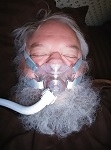Intellipap AP Auto v M Series w/Aflex??
Intellipap AP Auto v M Series w/Aflex??
Time for a new machine...and I can't decide between the two. I've read most of the reviews on this site and I'm leaning toward the Intellipap unit....but I really like the exhale relief of the C-Flex unit I have now...and would have on the A-Flex. Is the exhale relief a big deal?....thanks for your thoughts!
Re: Intellipap AP Auto v M Series w/Aflex??
Since you have the unit in hand, turn off the cflex and see.
Note that many would adjust pressure downward without the cflex.
Lack of pressure relief has never been a problem for me.
Fred
Note that many would adjust pressure downward without the cflex.
Lack of pressure relief has never been a problem for me.
Fred
_________________
| Machine: AirCurve™ 10 VAuto BiLevel Machine with HumidAir™ Heated Humidifier |
| Mask: AirFit™ P10 Nasal Pillow CPAP Mask with Headgear |
| Additional Comments: VAuto 11-25cmH2O PS 3 --- OSCAR software, Many masks - Amara View FFM to P10 Pillows Several Nasal and FFM |
Re: Intellipap AP Auto v M Series w/Aflex??
If you haven't already done so, check out the results of the CPAP.COM product challenge where they pitted the two machines you are considering against one another.
What is your CPAP pressure or APAP pressure range? At an APAP range of 9-12, I find it extremely easy to breathe out against the Intellipap, and don't think I'd bother with exhale relief even if it were available.
What is your CPAP pressure or APAP pressure range? At an APAP range of 9-12, I find it extremely easy to breathe out against the Intellipap, and don't think I'd bother with exhale relief even if it were available.
- timbalionguy
- Posts: 888
- Joined: Mon Apr 27, 2009 8:31 pm
- Location: Reno, NV
Re: Intellipap AP Auto v M Series w/Aflex??
I have never tried EPR features, but find that I can breathe just fine against even moderately high pressures (up to 16 so far). I like the compactness and features of the IntelliPAP. About the only disadvantage of this machine is that, while providing quite adequate data, it does not offer all the data features of the M series stuff. The IntelliPAP supposed has a whole lot of algorithms available to it, and can adapt quickly to any nuances in your breathing.
Lions can and do snore....
Re: Intellipap AP Auto v M Series w/Aflex??
Mysteriously, the Intellipap did nothing at all to treat my sleep apnea. This apparently isin't true for many. The Resperonics algorithm must fit me perfectly, and I love A-Flex which feels like the machine isin't even on.
Georgio
Georgio
DreamStation 2, Oscar
Resmed AirFit P30i Nasal Mask
Resmed AirFit P30i Nasal Mask
Re: Intellipap AP Auto v M Series w/Aflex??
Thanks all! As it turns out my supplier (Apria HC) does not sell the Intellipap....so it's time to upgrade to the M-Series w/A-Flex. My C-Flex has worked well and I'm looking forward to the "M".
Re: Intellipap AP Auto v M Series w/Aflex??
I don't know what makes you say that.timbalionguy wrote:I have never tried EPR features, but find that I can breathe just fine against even moderately high pressures (up to 16 so far). I like the compactness and features of the IntelliPAP. About the only disadvantage of this machine is that, while providing quite adequate data, it does not offer all the data features of the M series stuff. The IntelliPAP supposed has a whole lot of algorithms available to it, and can adapt quickly to any nuances in your breathing.
The Intellipap ignores flow limitation, has the same response to apneas and hypopneas, defines events as hypopneas where other companies would define them as apneas -- and responds to both exactly the same. Its identification of central apneas is based on arcane reasoning, and is correct only 85% of the time (That's what they say in their webinar). The only sophistication in the machine is the fact that it lets you define how soon an event should be responded to (how long the machine should wait before responding) and at what reduction in flow you want the response to start -once you set that up, it doesn't matter whether the event is a hypopnea or an apnes. DeVilbiss sells the machine set up to report more hypopneas than apneas by definition, because by default it uses a 90% reduction in flow as the point where an event gets called apnea (that's the lowest any company does). Any event between 90% and 50% is by (DeVilbiss') definition a hypopnea.
Other machines base their speed of response on previous breathing patterns -- doing some sophisticated calculations. The Intellipap does not - if you tell it to wait 20 seconds, it will do so all night long, for any stage of sleep you are in. The "Intelligence" and sophisticaion of its glorithm are limited to the level of reduction in breathing. The it goes all out, and does the same thing again and again no matter how you breathe.
I think the data in the software is inadequate for anyone who wants to do trouble shooting.
For example: can you get the average pressure (or 90th percentile?) per setting?
The EPI per setting? Leaks per setting?
Can you get a reliable report cover page, that reports the settings used on a range of dates?
The answer to all of the above is "no".
Do you realize that when you print a report, your last setting will appear on the cover page -- even if the dates refer to older settings?
I would not recommend the DeVilbiss to any new user. I realize most people who switched to it from a Respironics were happy -- they are not new users.
O.
_________________
| Mask: AirFit™ P10 Nasal Pillow CPAP Mask with Headgear |
| Additional Comments: Machine: Resmed AirSense10 for Her with Climateline heated hose ; alternating masks. |
And now here is my secret, a very simple secret; it is only with the heart that one can see rightly, what is essential is invisible to the eye.
Antoine de Saint-Exupery
Good advice is compromised by missing data
Forum member Dog Slobber Nov. 2023
Antoine de Saint-Exupery
Good advice is compromised by missing data
Forum member Dog Slobber Nov. 2023
Re: Intellipap AP Auto v M Series w/Aflex??
The IntelliPAP works well for me. Reviewing my nightly reports, I find that each pressure increase is usually preceded by snoring or a cluster of hypopneas. Increase is fast enough to quickly head off additional events but slow enough not to wake me up. In the 7 months I've had the machine, I've never seen it chase snores or otherwise run up the pressure unnecessarily. If you don't like DeVilbiss' 90% flow reduction definition of an apnea (or 50% definition of hypopnea), it can easily be changed to match the definitions that ResMed, Respironics, P/B, etc. use - either in setup mode on the LCD display or from the Smartlink software on your computer.ozij wrote: The Intellipap ignores flow limitation, has the same response to apneas and hypopneas, defines events as hypopneas where other companies would define them as apneas -- and responds to both exactly the same.
If I had one criticism of their algorithm, it would be that it seems a bit too relentless in backing off towards the minimum pressure. Not an issue set up as I have (with minimum set 1cm below my PSG titrated CPAP pressure), but I suspect this is a machine that would not do well set to lazy doctor mode (i.e. 3-20).
As for the definition of centrals, is it better science to assume that any apnea that occurs at 10cm of pressure (or more) is central as ResMed does? Or to always assume that it isn't central, try to bump three times, and then say "oops, must have been a central" if the bumps don't help, as Respironics does? I'm not sure what your P/B machine does - there is a section for sleep therapy whitepapers on their site, but I can't find any documents in it. You call DeVilbiss' method arcane, but the other companies are each taking very different approaches to detecting centrals, and I don't see anyone from those companies coming here to defend the science behind their methods either. My understanding is that the only way to reliably detect centrals is by using abdominal bands to sense respiratory effort, and that's something that no APAP can do. I know the algorithm doesn't work well for everyone (e.g. Georgio), but it works well for me, and apparently for most of those people who participated in the CPAP.COM product challenge.
I can and do recommend the IntelliPAP. It's a super quiet machine that's been a pleasure to use. The Smartlink reports could be a bit better -- and hopefully will get better in future releases of the monitoring software (current version is their first, no?), but they are good enough for me to track and make appropriate adjustments to my therapy. I've got nothing but good things to say about the company. I've emailed Kristen on a few occasions (about the product, not the science behind it), and she's always responded quickly with the information I needed. It's one of the very few companies in the industry that reaches out to end users for feedback and feature wish lists, and then incorporates those suggestions into their product. Those reasons, combined with the fact that the machine seems to be doing an excellent job at treating my OSA, have made me a satisfied customer.
Re: Intellipap AP Auto v M Series w/Aflex??
Respironics uses a technical definition of central apneas to refrain from error -- it may be good or bad, but it doesn't presume to be epidemiologically based.You call DeVilbiss' method arcane, but the other companies are each taking very different approaches to detecting centrals, and I don't see anyone from those companies coming here to defend the science behind their methods either. My understanding is that the only way to reliably detect centrals is by using abdominal bands to sense respiratory effort, and that's something that no APAP can do.
Resmed and Puritan Bennett base their algorithmic decisions on scientific data published in peer reviewed journals -- as has been mentioned, and linked to more that once in this forum. You can find the science mentioned in my posts if you are interested in the science.
DeVilbiss has ignored questions about their definition of apneas.
I asked Kristin publicly more than once, on this forum, starting at the end of May about the or even empiric data behind their identification method -- and was utterly ignored - on threads she clearly read. I had naively assumed she was here to communicate with users. "Arcane" means "known or understood by very few; mysterious; secret; obscure". I asked Kirsten to reveal the data - the was not revealed. I did not attack the science behind the decision - I had no reason to do so. The question was ignored.
That is exactly my point. The apnea adjustment is a cosmetic issue. I have no doubt the machine's default it liked by DeVilbiss marketing, since it gives hardly an apneas and only hypopneas. More than one user was captivated by that result, surprised and happy to discover the machine gave them no apneas - without realizing it's cosmetics.If you don't like DeVilbiss' 90% flow reduction definition of an apnea (or 50% definition of hypopnea), it can easily be changed to match the definitions that ResMed, Respironics, P/B, etc. use - either in setup mode on the LCD display or from the Smartlink software on your computer.
Unlike the apnea definition -- which is pure cosmetics, the hypopnea definition is supposed to make the machine less or more responsive; changing it from 50% will change the machine's behavior, and should not be attempted because a person "likes" or "dislikes" it. And the there will be many people confused by whether 40% (for hypopneas) or 60% makes the machine more responsive. And they will be confused because of the abysmal human engineering on that software / hardware /human interface.
My points were two: 1. I would not recommend the machine for beginners: nobody in that challenge was a beginner; 2.The software is useless for troubleshooting -- and Georgio is a case in point: troubleshooting was useless when trouble appeared.I know the algorithm doesn't work well for everyone (e.g. Georgio), but it works well for me, and apparently for most of those people who participated in the CPAP.COM product challenge
When a company sells software in which the last settings are printed on the cover page ast though they belong to the date you selected -- and do not at all represent real settings for that date, it indicates a disdain for proper recording, a lack of quality testing that makes my hair stand on end. I would not touch their devices with a barge pole -- because the same lack of quality testing may exist elsewhere too. It's not as though they gave the software out for beta testing.Smartlink reports could be a bit better -- and hopefully will get better in future releases of the monitoring software (current version is their first, no?), but they are good enough for me to track and make appropriate adjustments to my therapy.
By the way, how do you like the bizzare pressure scale (y axis) on the nightly report, that reads like this (bottom up):
2
5
8
10
12
15
18
21
The graphic distance does not even represent those inconsistent numerical differences - so you can't compare the slant of the graph at one point, to its slant at another.
Programmed by an ignoramus, and quality tested by nobody.
No need to reply to my question -- the software was good enough for you.
Smartlink doesn't indicate when a person pushed ramp at night -- important info for tracking a beginner's response to therapy.
I use a 5 minute ramp as an idicator of restless sleep -- hit ramp when I'm really woken up by something. Couldn't do that on the DeVilbiss because ramp and settling (DV's delay) are the same -- and with a 5 minute delay, pressure started shooting up when I was wide awake, tossing and turning and trying to fall asleep.
Smartlink is not a tool for any serious use.
The algorithm did not work for me - maybe because my snores are handled at very low pressure, but I have other events -- some central -- and the Devilbiss was chasing them.
I don't expect every algorithm to work for me -- but I expect basic quality control on software people pay for.
I'm glad you like the machine and it serves you well. In my opinion, it's a machine for experienced users who know their settings. I would not recommend it for beginners or anyone who needs troubleshooting.
O.
_________________
| Mask: AirFit™ P10 Nasal Pillow CPAP Mask with Headgear |
| Additional Comments: Machine: Resmed AirSense10 for Her with Climateline heated hose ; alternating masks. |












